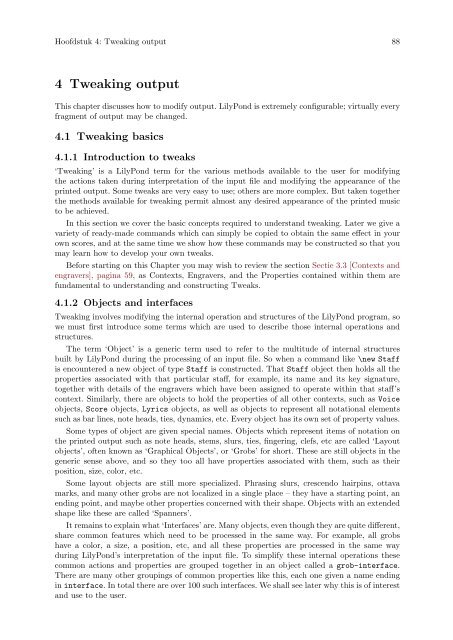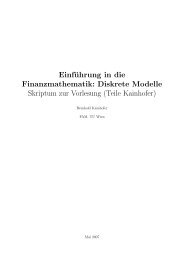LilyPond Beginnershandleiding
LilyPond Beginnershandleiding
LilyPond Beginnershandleiding
Create successful ePaper yourself
Turn your PDF publications into a flip-book with our unique Google optimized e-Paper software.
Hoofdstuk 4: Tweaking output 88<br />
4 Tweaking output<br />
This chapter discusses how to modify output. <strong>LilyPond</strong> is extremely configurable; virtually every<br />
fragment of output may be changed.<br />
4.1 Tweaking basics<br />
4.1.1 Introduction to tweaks<br />
‘Tweaking’ is a <strong>LilyPond</strong> term for the various methods available to the user for modifying<br />
the actions taken during interpretation of the input file and modifying the appearance of the<br />
printed output. Some tweaks are very easy to use; others are more complex. But taken together<br />
the methods available for tweaking permit almost any desired appearance of the printed music<br />
to be achieved.<br />
In this section we cover the basic concepts required to understand tweaking. Later we give a<br />
variety of ready-made commands which can simply be copied to obtain the same effect in your<br />
own scores, and at the same time we show how these commands may be constructed so that you<br />
may learn how to develop your own tweaks.<br />
Before starting on this Chapter you may wish to review the section Sectie 3.3 [Contexts and<br />
engravers], pagina 59, as Contexts, Engravers, and the Properties contained within them are<br />
fundamental to understanding and constructing Tweaks.<br />
4.1.2 Objects and interfaces<br />
Tweaking involves modifying the internal operation and structures of the <strong>LilyPond</strong> program, so<br />
we must first introduce some terms which are used to describe those internal operations and<br />
structures.<br />
The term ‘Object’ is a generic term used to refer to the multitude of internal structures<br />
built by <strong>LilyPond</strong> during the processing of an input file. So when a command like \new Staff<br />
is encountered a new object of type Staff is constructed. That Staff object then holds all the<br />
properties associated with that particular staff, for example, its name and its key signature,<br />
together with details of the engravers which have been assigned to operate within that staff’s<br />
context. Similarly, there are objects to hold the properties of all other contexts, such as Voice<br />
objects, Score objects, Lyrics objects, as well as objects to represent all notational elements<br />
such as bar lines, note heads, ties, dynamics, etc. Every object has its own set of property values.<br />
Some types of object are given special names. Objects which represent items of notation on<br />
the printed output such as note heads, stems, slurs, ties, fingering, clefs, etc are called ‘Layout<br />
objects’, often known as ‘Graphical Objects’, or ‘Grobs’ for short. These are still objects in the<br />
generic sense above, and so they too all have properties associated with them, such as their<br />
position, size, color, etc.<br />
Some layout objects are still more specialized. Phrasing slurs, crescendo hairpins, ottava<br />
marks, and many other grobs are not localized in a single place – they have a starting point, an<br />
ending point, and maybe other properties concerned with their shape. Objects with an extended<br />
shape like these are called ‘Spanners’.<br />
It remains to explain what ‘Interfaces’ are. Many objects, even though they are quite different,<br />
share common features which need to be processed in the same way. For example, all grobs<br />
have a color, a size, a position, etc, and all these properties are processed in the same way<br />
during <strong>LilyPond</strong>’s interpretation of the input file. To simplify these internal operations these<br />
common actions and properties are grouped together in an object called a grob-interface.<br />
There are many other groupings of common properties like this, each one given a name ending<br />
in interface. In total there are over 100 such interfaces. We shall see later why this is of interest<br />
and use to the user.



